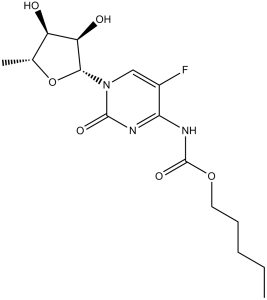Capecitabine (Xeloda)
This product is for research use only, not for human use. We do not sell to patients.

For small sizes, please check our retail website as below: www.invivochem.com
| Size | Price | Stock |
|---|---|---|
| 10g | $250 | Check With Us |
| 50g | $800 | Check With Us |
| 100g | $1200 | Check With Us |
Cat #: V1454 CAS #: 154361-50-9 Purity ≥ 98%
Description: Capecitabine (formerly RO 09-1978; RO-09-1978; RO09-1978; CAPE; Trade name: Xeloda) is an anticancer chemotherapeutic medication approved for treating breast cancer, gastric cancer and colorectal cancer.
Top Publications Citing Invivochem Products
Publications Citing InvivoChem Products
Product Promise

- Physicochemical and Storage Information
- Protocol
- Related Biological Data
- Stock Solution Preparation
- Quality Control Documentation
| Molecular Weight (MW) | 359.35 |
|---|---|
| Molecular Formula | C15H22FN3O6 |
| CAS No. | 154361-50-9 |
| Storage | -20℃ for 3 years in powder formr |
| -80℃ for 2 years in solvent | |
| Solubility In Vitro | DMSO: 72 mg/mL (200.4 mM)r |
| Water: 6 mg/mL (16.7 mM)r | |
| Ethanol: 72 mg/mL (200.4 mM) | |
| Synonyms | RO09-1978; Ro 091978000; Ro-091978000; Ro091978000; Capecitabine; RO-09-1978; RO 09-1978; Abbreviation: CAPE. Trade name: Xeloda. |
| Protocol | In Vitro | Capecitabine is an anti-cancer chemotherapy drug. It is classified as an antimetabolite. Capecitabine is converted into 5′-deoxy-5-fluorocytidine (5′DFCR), 5′-deoxy-5-fluorouridine (5′DFUR) and 5-FU by carboxylesterases (CES1 and 2), cytidine deaminase (CDD), and thymidine phosphorylase (TP), in both liver and tumour. Capecitabine induces a significant cytotoxic effect in vitro only at high concentrations. Mean IC50 values vary from 860 μM in COLO205 cells to 6000 μM in HCT8 cells |
|---|---|---|
| In Vivo | Capecitabine is an anti-cancer chemotherapy drug. It is classified as an antimetabolite. Capecitabine is converted into 5′-deoxy-5-fluorocytidine (5′DFCR), 5′-deoxy-5-fluorouridine (5′DFUR) and 5-FU by carboxylesterases (CES1 and 2), cytidine deaminase (CDD), and thymidine phosphorylase (TP), in both liver and tumour. Capecitabine induces a significant cytotoxic effect in vitro only at high concentrations. Mean IC50 values vary from 860 μM in COLO205 cells to 6000 μM in HCT8 cells |
These protocols are for reference only. InvivoChem does not
independently validate these methods.
| Solvent volume to be added | Mass (the weight of a compound) | |||
|---|---|---|---|---|
| Mother liquor concentration | 1mg | 5mg | 10mg | 20mg |
| 1mM | 2.7828 mL | 13.9140 mL | 27.8280 mL | 55.6560 mL |
| 5mM | 0.5566 mL | 2.7828 mL | 5.5656 mL | 11.1312 mL |
| 10mM | 0.2783 mL | 1.3914 mL | 2.7828 mL | 5.5656 mL |
| 20mM | 0.1391 mL | 0.6957 mL | 1.3914 mL | 2.7828 mL |
The molarity calculator equation
Mass(g) = Concentration(mol/L) × Volume(L) × Molecular Weight(g/mol)
Mass
=
Concentration
×
Volume
×
Molecular Weight*
The dilution calculator equation
Concentration(start)
×
Volume(start)
=
Concentration(final)
×
Volume(final)
This equation is commonly abbreviated as: C1 V1 = C2 V2
Concentration(start)
C1
×
Volume(start)
V1
=
Concentration(final)
C2
×
Volume(final)
V2
Step One: Enter information below
Dosage mg/kg
Average weight of animals g
Dosing volume per animal µL
Number of animals
Step Two: Enter the in vivo formulation
%DMSO
+
%
+
%Tween 80
+
%ddH2O
Calculation Results:
Working concentration:
mg/ml;
Method for preparing DMSO master liquid:
mg
drug pre-dissolved in
µL
DMSO(Master liquid concentration
mg/mL)
,Please contact us first if the concentration exceeds the DMSO solubility of the batch of drug.
Method for preparing in vivo formulation:
Take
µL
DMSO master liquid, next add
µL
PEG300, mix and clarify, next add
µL
Tween 80,mix and clarify, next add
µL
ddH2O,mix and clarify.
Note:
- (1) Please be sure that the solution is clear before the addition of next solvent. Dissolution methods like vortex, ultrasound or warming and heat may be used to aid dissolving.
- (2) Be sure to add the solvent(s) in order.




































